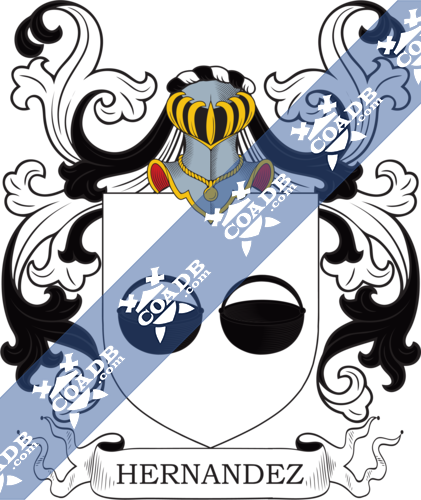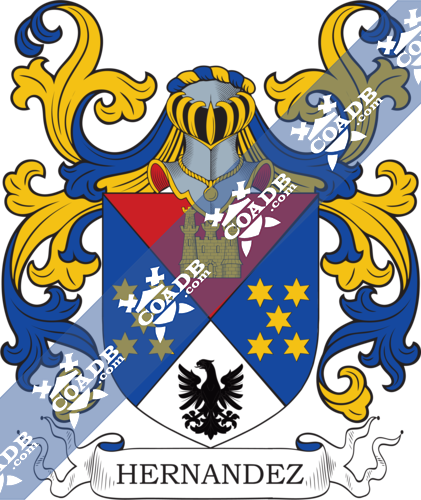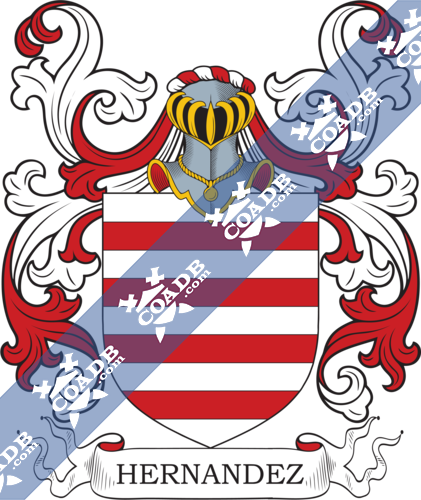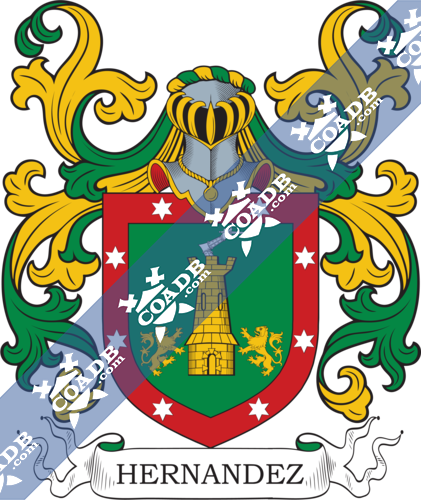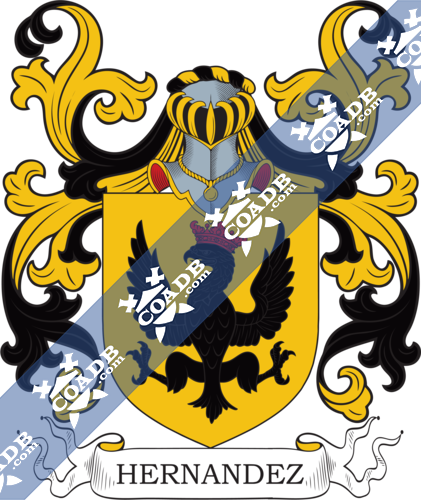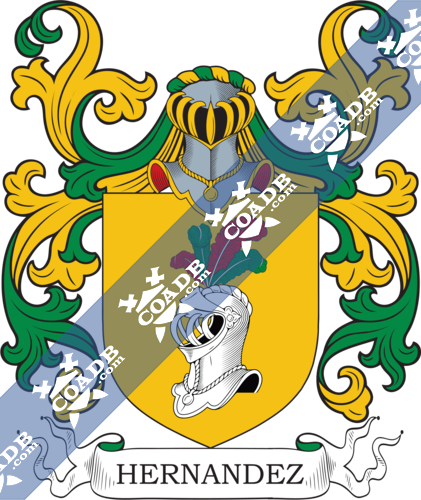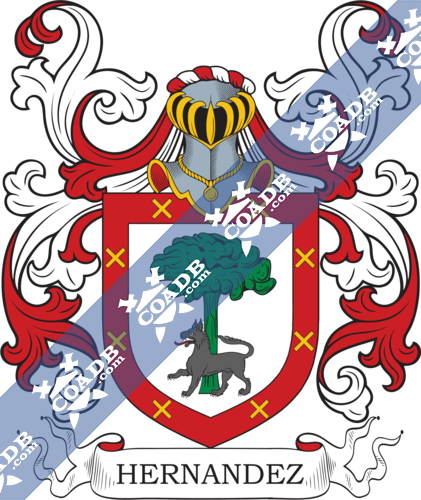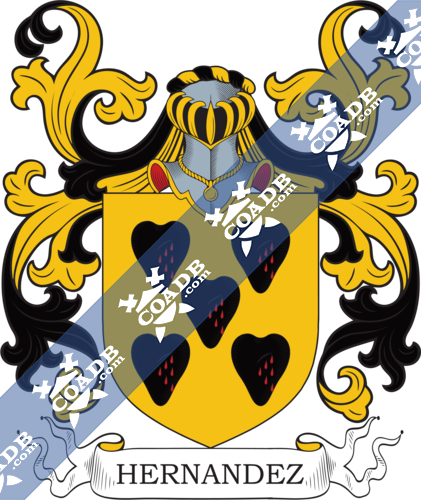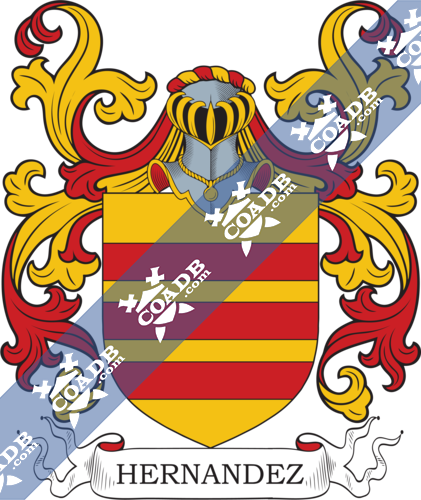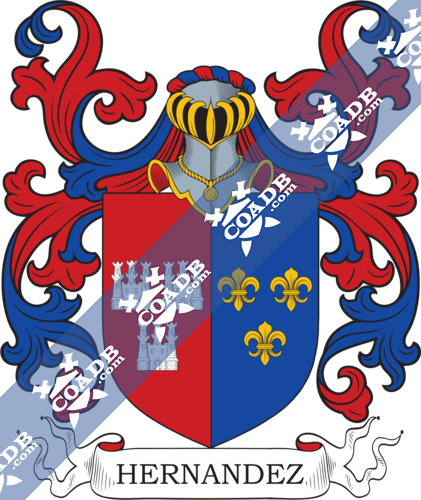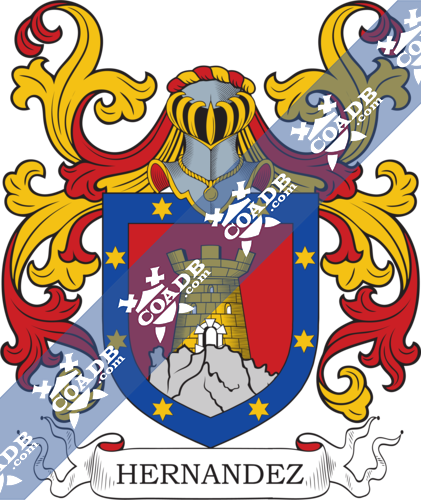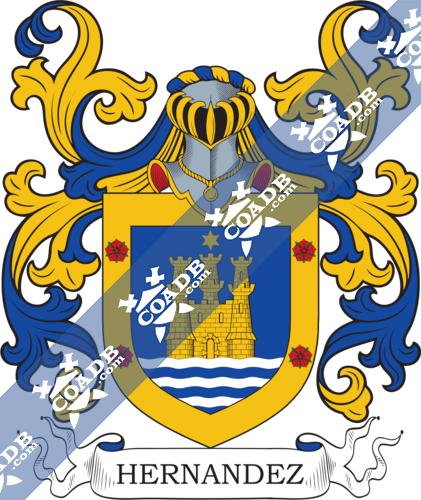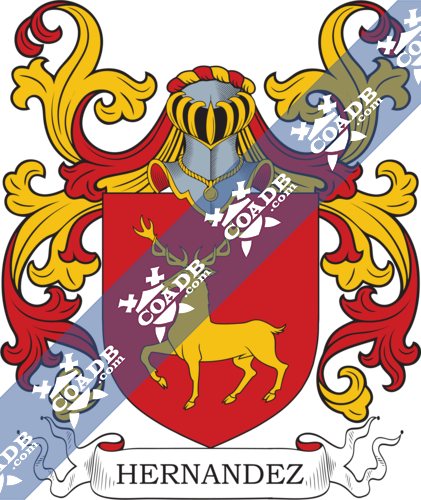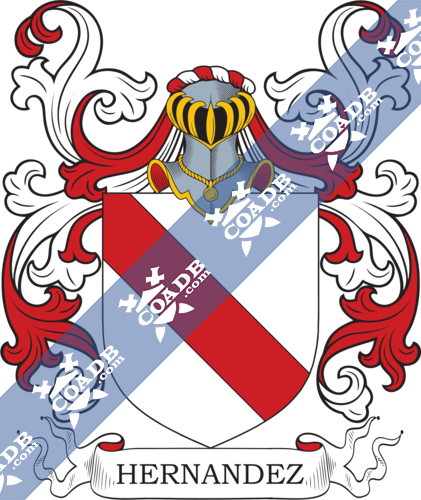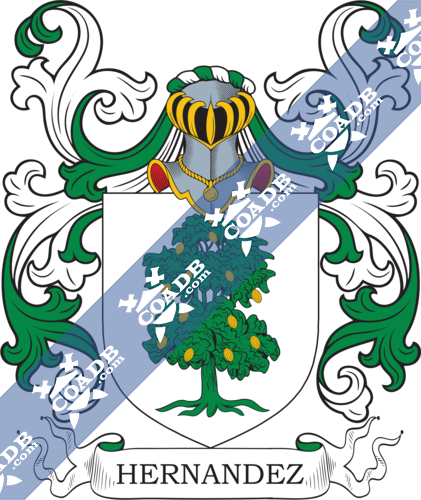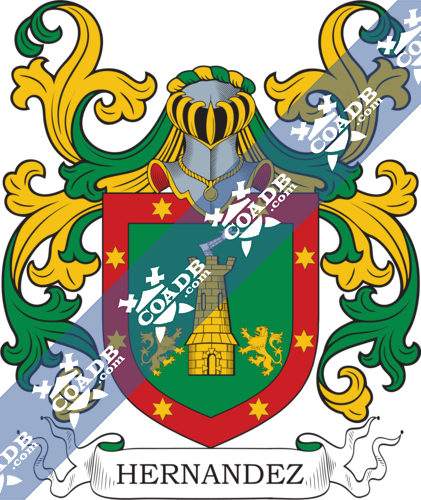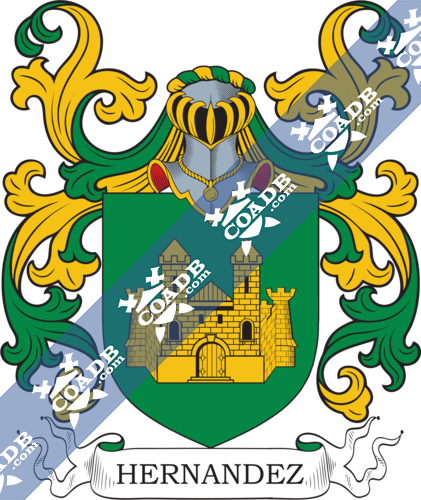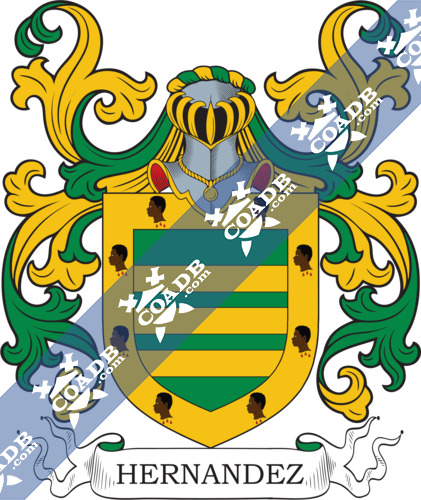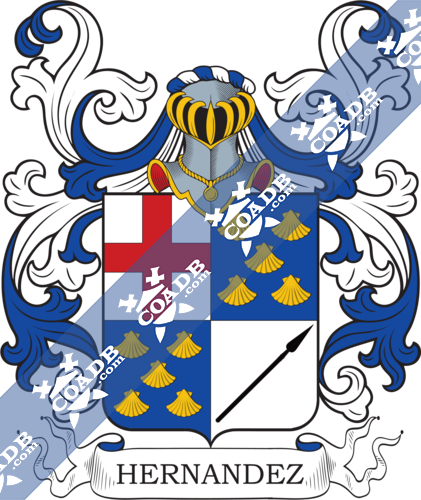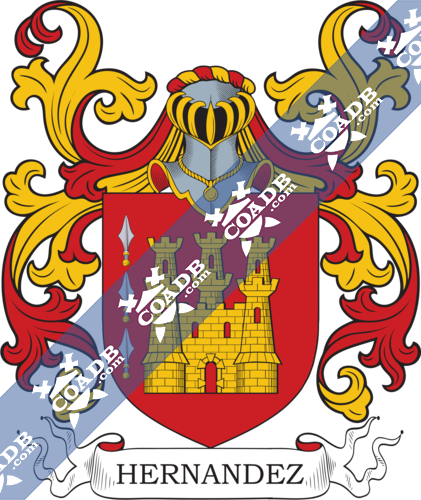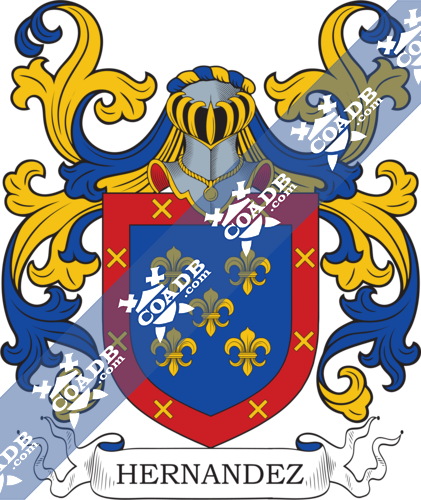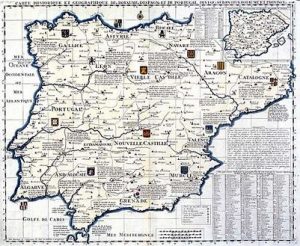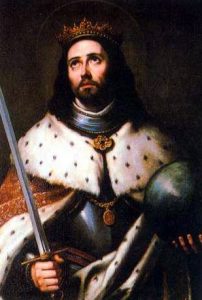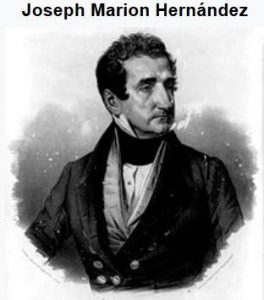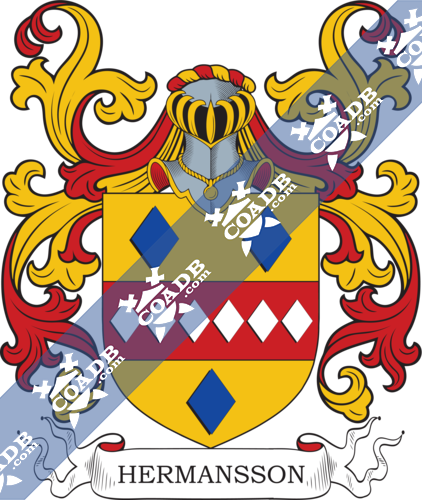Hernandez Family Crest, Coat of Arms and Name History

Hernandez Coat of Arms Gallery
Don’t know which Coat of Arms is yours?
We can do a genealogical research. Find out the exact history of your family!
Learn MoreSurname Meaning, Origin, and Etymology
The surname Hernandez has its origin in the Iberian Peninsula around the 15th century. Just like many other surnames from that area and time, this is a patronymic surname, which means that it is a derivation of the name of the father of the bearer. This can be identified by the presence of the suffix “ez,” which means “son of…” in Spanish, and this is what grants this last name the meaning of “son of Hernando” or “son of Hernan.” As is normal with patronymic surnames, there are a lot of lineages of Hernandez that are not related to each other.
Etymologically, Hernandez is a word derived from the name Ferran, which means “warrior.” At the same time, it is a derivation of the Celtic word “Har” which means “war” or “power.” Some experts claim that this surname also comes from the Spanish words “faro,” which means “journey,” and “nano” which means brave, giving Hernández the meaning of “brave traveler.” These are the roots of the names Hernando and Fernando, and these two names originated the Hernandez and Fernandez surnames. As can be seen, these surnames have the same origin, which is why they are so closely related. In fact, in its Portuguese version, Hernandez means “son of Fernando.”
These two last names became very popular after the death of King Ferdinand III of Castile and Leon, who reconquered Spain from the Moors. After his death, he was canonized, so people started naming their sons Fernando or Hernando to honor him. There are experts who believe that the reason why the Hernandez lineages from Spain use a variation of the French royal arms is because they are descendants of the French royal house of Valois. One of the first appearances of this surname actually belongs to its most popular variation – Fernandez. This is thanks to Asur Fernandez, a count of Monzon who lived during the 10th century.
Spelling Variations
Thanks to the fact that Hernandez has its origin in two languages – Spanish and Portuguese – it has several spelling variations. There are also other reasons that caused the development of these variations such as the mixture of languages in Europe during the Medieval Era. At that time, words were written according to how they sounded, including surnames, which caused mistakes when translating them. Due to all of this, the most popular variations of Hernandez are Hernan, Hernanz, Hernández, Hernandez, Fernant, Farrant, Fernan, Fernao, Ferrao, Hernaez, Hernaiz, Fernandez, Fernández, Ferrandez, Ferrandiz, Fernandes, Hernandes and several more. It is important to remark the importance of the accent mark in Spanish, given that its absence or presence can lead to two different words, which is why Hernandez and Hernández are considered two different words and are also considered spelling variations.
Popularity & Geographic Distribution
Hernandez is one of the most popular surnames in the entire word, not only in Europe but also in America, given that this territory was colonized by the countries of the Old Continent. According to the census of 2014, Hernandez is the 85th most common surname on the planet. There are 5,689,160 people who bear it, and the country where it is most prevalent is Mexico. Furthermore, it has its highest density in Nicaragua. The second country in prevalence is the United States, followed by Colombia in third place and Venezuela in fourth place.
Early Bearers of the Surname
Some of the early bearers of the surname Hernandez or Fernandez were Diego Fernandez, count of Saldaña and Carrion in the 11th century; Gonzalo Fernandez from Córdoba, who was a captain of the Spanish army during the reign of King Ferdinand; Antonio Fernandes, an important Portuguese explorer of the 15th century, and the explorer Joao Fernandes, who was also from Portugal and lead expeditions to West Africa in the 15th century.
History, Genealogy, and Ancestry
Hernandez is a patronymic surname, which has the particularity of having several lines that do not have any sort of relation with one other. Therefore, not all bearers of the Hernandez surname are part of the same family. In fact, there are thousands of different family groups with this surname.
One of the branches of Hernandez that relies on a highly detailed genealogical line is the one which was related to the Pinzón family. The brothers with this last name who traveled with Cristopher Columbus to America are from this line. Said line began with Diego Hernández Colmenero, who in 1496 got married to Catalina Pinzón Alvárez. Pedro Hernández Colmenero Pinzón was born from this marriage, but there are no records as to who was his wife, or if he ever had one. Fortunately, there are records about his son, who bore the same name, Pedro Hernández Pinzón. Years later, Pedro Hernández Pinzón’s son got married to Beatriz González in 1563, and they named their first son Alonso Martín Hernández Pinzón. Alonso was born in 1564, and he got married to Ana Suarez in 1588. Their firstborn son was Antonio Hernández Pinzón Suarez, who was known as Antón Hernández Pinzón. He was born in 1591 and took Juana Grande de la Coba as his wife in the year of 1633.
The first child of Antón and Juana was named after his grandfather, Alson Hernández Pinzón, and he was born in 1637. Years later, in 1675, he got married to Inés Rodríguez. From this union, Francisco Hernández Pinzón was born in Moguer, Spain in 1676. Francisco was baptized in the Nuestra Señora de la Granada church on November 10, 1676, and he got married in the city of Moguer to Catalina Benítez Herrera on December 4, 1707. The eldest son of Francisco and Catalina was named José Hernández Pinzón, and he was also born in Morgue, Spain in 1717. He was baptized in the same church as his father.
When José Hernández Pinzón grew up, he became a Major or Ensign and life ruler of the city of Morgue. He received the status of nobleman from the crown, and he got married to Ignacia Prieto Tenorio on March 19, 1751. They had five children: Juan Hernández Pinzón, José Joaquín Hernández Pinzón, the names of the two following offspring are unknown, and Luis Hernández Pinzón. The eldest son, Juan Hernández Pinzón, was born on 1756 in the city of Moguer, but this is all that is known about him, as there are no records of his offspring or if he ever had any.
From this point on, the family line split in two, one was the line of José Joaquín and the other of Luis. The line of José Joaquín Hernández Pinzón Prieto continued when he got married to Jerónima Ramos Prieto Thenorio y Galván. Their first son was Antonio Hernández Pinzón Ramos. Antonio married María Gracia Berrueco in 1820, and they had a son named Antonio Hernández Pinzón Berrueco, who was born in 1838. Then, he married Dolores Flores Tello in 1873 and their firstborn was José Hernández Pinzón Flores, who was born in 1875. José married Victoria Jiménez Mantecón in 1902, and they had five children: Victoria, Dolores, Blanca, Francisco, and José Hernández Pinzón Jiménez.
The line continued with Franciso Hernández Pinzón, who was born in Moguer on July 4, 1918. Francisco had a very successful military career during the Spanish Civil War, and he earned the rank of Colonel Honorary of Artillery at the moment of his retirement. He married Carmen Moreno Vergara in 1945, with whom he had eight children, including seven daughters and one son. Francisco Hernández Pinzón died on April 30, 2010.
The other line was that of Luis Hernández Pinzón Prieto, who became an officer in the Navy and had a son, Luis Hernández Pinzón Álvarez, in Moguer on December 23, 1816. He also joined the Navy. Luis Hernández Pinzón Álvarez became the 28th General Captain and Admiral of the Spanish Royal Navy during the reign of Isabell II, when Spain faced Peru in a war for the control of the guano. He then joined politics and became a Member of the Parliament and then a Senator. He got married to María Teresa Balleras and Monroy, and their firstborn was José Luis Hernández Pinzón Balleras. Luis Hernández Pinzón Álvarez died on February 22, 1891, in his hometown of Moguer, and his wife died on September 5, 1920, when she was 84 years old.
José Luis Hernández Pinzón Balleras was a Member of Parliament in 1892, and he got married to Concepción Ganzinotto, with whom he had 3 children. Their firstborn was José Luis Hernández Pinzón Ganzinotto, and he was born in 1893. Their next child was Concepción, who was born in 1894, and they later had another daughter named Victoria.
José Luis Hernández Pinzón Ganzinotto became Lieutenant Colonel of the Marine Infantry, a lawyer, and even published a book. He married María Dolores Garrido Garrido, and they only had one daughter, María Teresa Hernández Pinzón Garrido, on August 7, 1936. José Luis was killed on July 22, 1936, in the civil war. María Teresa Hernández Pinzón Garrido married Manuel Varillas, and they had a daughter, María Victoria Varillas Hernández Pinson.
There are others records about different Hernández family members from Spain. In the town known as Moya, there are more lines of the original Hernandez family. One of them started with Ensign Diego Hernández, who was born in 1569 and married María Trujillo De Armas. They only had one child, José Hernández Días, who married María de Almeida in 1629. This last marriage bore children, but they took the last name of their mother.
Also in Moya, there was Andrés Hernández, who married Isabel Sosa. They had a son, Sebastián Hernández, who was born in 1642. Sebastián married Ana de Palenzuela Trujillo.
Early American and New World Settlers
Despite the big popularity of the Hernández surname, there are not many records of the arrival of its bearers from Europe to America after the New Continent was discovered by Cristopher Columbus in 1492. There only a few examples, such as Cayetano Hernández, who arrived in Puerto Rico in 1803; Joaquín Hernández, who also landed in Puerto Rico in the same year, and America Catalina Hernández, Diego Hernández, and Isabel Hernández, who all arrived in 1811.
Mottoes
We were unable to locate any documented mottoes for the Hernández family.
Grantees
We were unable to locate any documented grantees for the Hernández family.
Notables
There is a long list of bearers of the surname Hernández who played important roles in different areas. From literature to sports, several bearers of the Hernández surname have offered their services for a good cause. Some of the most important ones are Carlos Enrique Hernández Ramos (1940-2016), a world champion professional boxer from Venezuela; Claudia Hernández, a model and beauty queen from Peru; Anabel Hernández (born in 1972), a Mexican Journalist; Xavi Hernández (born in 1980), a great football player from Spain; Gregorio Evelio Hernández López (1930-2015), a Major League Baseball player from Cuba, and American singer Peter Gene Hernández (born in 1985), who is best known as Bruno Mars and is a big name in today’s music industry. In other fields such as politics, there was Joseph Marion Hernández (1793-1857), an American politician who was the first person with Spanish ascendancy to have worked in U.S. Congress; former President of El Salvador, Maximiliano Hernández Martínez, and Mexican politician Rafael Hernández Ochoa (1915-1990). In science, there were also important Hernández bearers such as Venezuelan physician José Gregorio Hernández (1864-1919), who has become a cult figure in this region given that many people claim to be healed by him in a miraculous way.
Blazons & Genealogy Notes
1) Los de Aragón, traen: Escudo partido: 1º, en campo de gules, un león rampante, de oro; y 2º, en campo de plata, dos fajas de veros. English: Per pale, 1st gu., a lion rampant or, 2nd Ar, two bars vair.
2) Los de Castilla, traen: Escudo partido: 1º, en campo de gules, tres castillos, de plata, bien ordenados; y 2º, en campo de azur, tres flores de lis, de oro, bien ordenadas. English: Per pale, 1st gu., three castles ar, well ordered, 2nd Az, three fleur de lis or, well ordered.
3) Otros de Castilla, traen: En campo de sinople, una torre, de oro, acostada de dos leones, del mismo metal; de las almenas de la torre sale un brazo armado, de plata, empuñando una espada desnuda; bordura de gules con ocho estrellas, de oro. English: Vert, a tower or surrounded by two lion of the last, from the battlements issuing an arm in armour holding a sword ar., all within bordure gu, charged with eight stars of the second.
4) Otros traen: En campo de sinople, una villa, de oro. English: Vert, a villa (vilage) or.
5) Radicado en Armanza de Cameros (Logroño) y extendidos a Logroño, Burgos y Vitoria, traen: En campo de sinople, tres bandas de oro; bordura de oro con ocho cabezas de moro sangrantes. English: Vert, three bars or, within bordure of the same charged with eight Moors heads dripping a blood.
6) Otros traen: Escudo cuartelado: 1º, en campo de plata, una cruz, de gules, 2º y 3º, en campo de azur, cinco veneras, de oro, puestas en sotuer, y 4º en campo de plata, una lanza, de sable. English: Quaterly, Ar and Az, 1st a cross gu, 2nd and 3rd five escallops or.,saltirewise, 4th a spear sa.
7) Radicado en Logroño y extendido a Madrid y Jaén, traen: En campo de gules, un castillo, de oro, almenado, aclarado de gules y mazonado de sable, adiestrado de tres puntas de lanza, puestas en palo. English: Gu, a castle or, crenellated, openings of the first, masoned sa., at dexter side three spearheads in pale.
8) Otros radicados en San Antonio de los Baños, La Habana (Cuba), traen: En campo de azur, cinco flores de lis, de oro, puestas en sotuer; bordura de gules, con ocho aspas, de oro. English: Az, five fleur de lis or, saltirewise, within bordure gu., charged with eight saltires of the second.
9) Los radicados en Galicia, pasado a Canarias y a las Indias, traen: En campo de gules, tres aspas, de oro, bien ordenadas. English: Gu, three saltires or, well ordered.
10) Otros traen: En campo de plata, dos calderas, de sable, puestas en faja. English: Ar, two cauldrons sa, fessewise.
11) Otros traen: En campo de oro, cinco árboles, de sinople, arrancados y puestos en sotuer. English: Or, five trees eredicted, vert, saltirewise.
12) Los de la casa de Munaga, en Álava, traen: Escudo cuartelado en sotuer: 1º, en campo de gules, un castillo, de oro, 2º y 3º, en campo de azur, cinco estrellas, de oro, puestas en sotuer; y 4º, en campo de plata, un águila de sable. English: Per saltire, in chief gu, a castle or, in each flank az, five stars of the second saltirewise, in base ar an eagle sa.
13) Los de León, traen: En campo de plata, cuatro fajas, de gules. English: Ar, four bars gu.
14) Otros, originarios de Vilanova (Portugal), pasados a la Florida (EE.UU.) en 1768 y a Matanzas (Cuba) en 1820, radicado en Miami, Valencia (Venezuela) y Charlotte, Carolina del Norte, traen: En campo de sinople, una torre, de oro, acostado de dos leones del mismo metal; de las almenas de la torre sale un brazo armado, de plata, empuñando una espada desnuda; bordura de gules con ocho estrellas de plata. English: Vert, a tower or surrounded by two lion of the last, from the battlements issuing an arm in armour holding a sword ar., all within bordure gu, charged with eight stars of the third.
15) Otros traen: En campo de oro, un águila, de sable, coronada de gules. English: Or, and eagle sa, crowned gu.
16) Otros traen: En campo de oro, un casco de plata, perfilado de sable, con plumas de colores. English: Or, a helmet ar, profiled sa., with colored plumes.
17) La casa de la villa de Manjarres, trae: En campo de plata, un pino de sinople, y atravesado al tronco, un lobo de su color, lampasado de gules; bordura de gules, con ocho sotueres, de oro. English: Ar, a pine tree, traversed at the trunk with wolf passant ppr. Langued gu, within bordure of the last charged with eight saltires or.
18) Otros traen: En campo de oro, cinco panelas, de sable, goteando sangre y puestas en sotuer. English: Or, five hearts sa, dripping a blood, saltirewise.
19) Otros traen: En campo de oro, tres fajas, de gules. English: Or, three bars gu.
20) Otros, radicados en Güimar (Tenerife) y Santa Cruz de Tenerife, traen: Escudo cortado: 1º, en campo de azur, tres flores de lis; bordura de gules, con ocho aspas, de oro y 2º, en campo de azur, una cruz, a todo trance, acompañada en cada hueco, por una flor de lis, de plata. English: Per fesse, 1st Az, five fleur de lis, within bordure gu, charged with eight saltires or., 2nd Gu, between a cross or, four fleur de lis ar.
21) El Emperador D. Carlos I concedió, por privilegio dado en Valladolid a 4 de abril de 1542, el siguiente escudo de armas a D. Diego Hernández vecino de Arequipa: En campo de gules, un peñasco, al natural, sumado de una torre, de oro y plata; bordura de azur, con ocho estrellas, de oro. English: Gu, ona cliff ppr., a tower or and ar, within bordure az, charged with eight stars or.
22) El mismo Emperador concedió, por privilegio dado en Valladolid a 8 de junio de 1538, el siguiente escudo de armas a D. Gonzalo Hernández, regidor de la villa de Santo Espíritu (Nueva España): En campo de azur, un castillo de oro sobre ondas de azur y plata, superado de una estrella, de oro; bordura de oro, con cuatro rosas de gules, con hojas de sinople. English: Az, on waves ar and az, a castle or, surrmounted by star of the last, within bordure of the same charged with four roses gu, barbed vert.
23) Otros, radicados en Requena (Valencia), traen: En campo de gules, un ciervo pasante, de oro. English: Gu, a stag passant or.
24) Otros, radicados en Guadalupe y Guanajuato (México), traen: En campo de plata, una banda, de gules. English: Ar, a bend gu.
25) Otros, originarios de Almendralejo (Badajoz), radicados en Veracruz (México), traen: En campo de plata, un olmo, de sinople, arrancado y frutado de oro. English: Ar, an elm tree eredicted vert, fructed or.

